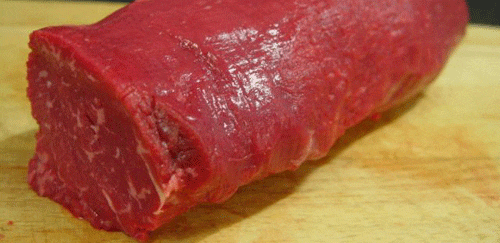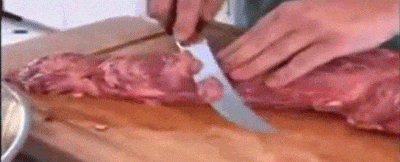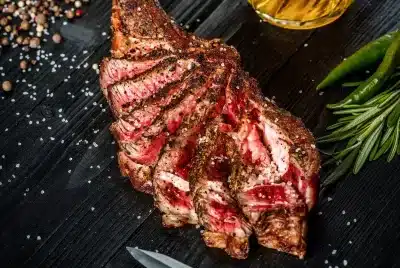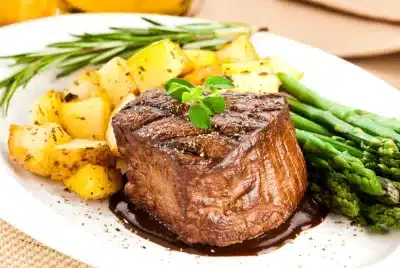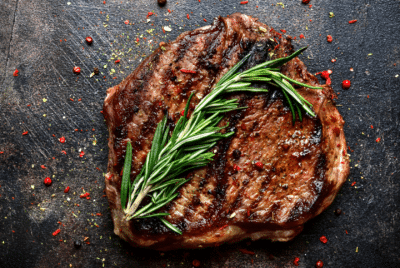Beef Cut – Tenderloin
 The tenderloin is part of the back of the cow. This muscle, the musculaus proas major, is situated under the lumbar vertebrae in the abdominal cavity and extends through the pelvis to the thigh at the hip.
The tenderloin is part of the back of the cow. This muscle, the musculaus proas major, is situated under the lumbar vertebrae in the abdominal cavity and extends through the pelvis to the thigh at the hip.
This piece of meat is considered the best beef there is.
There are three main cuts made of the tenderloin: the butt, the center-cut, and the tail.
The butt end is usually suitable for carpaccio, as the eye can be quite large; cutting a whole tenderloin into steaks of equal weight will yield proportionally very thin steaks from the butt end.
The center-cut is suitable for portion-controlled steaks as the diameter of the eye remains relatively consistent. The center-cut can yield the traditional filet mignon or tenderloin steak, as well as the Chateaubriand and Beef Wellington.
The tail, which is generally unsuitable for steaks due to consistency of size concerns, can be used in recipes where small pieces of a tender cut are called for.
Table of Contents
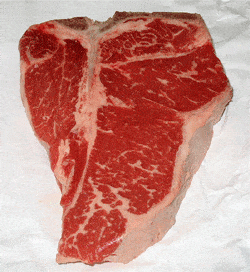 Tenderloin on the Porterhouse Steak
Tenderloin on the Porterhouse Steak
Most people know the tenderloin from the T-bone and Porterhouse steaks. Porterhouse steaks are cut from the rear end of the short loin and thus include more tenderloin steak, along with (on the other side of the bone) a large strip steak. T-bone steaks are cut closer to the front and contain a smaller section of tenderloin.
Processing and preparation
Whole tenderloins are often sold as “unpeeled.” This means that the fat and silver skin remain on the meat. If sold as “peeled,” then the fat is removed, but the silver skin remains. And they get sold as “psmos”, which is short for peeled, silver skin removed, and side muscle left on.
If you think a tenderloin is not a piece of meat that you can afford, than you may be wrong. A completely cleaned tenderloin is three to four times the price of uncleaned one. So ask your butcher for a unpeeled tenderloin and learn how to do the cleaning yourself.
Don’t think there is a shortcut because the unpeeled tenderloin is very chewy. Trimming the silver skin can be a tricky process that easily goes wrong. Inexperienced meat cutters can damage the steaks, reducing either the yield or the visual presentation. So take the time to watch the video below and make sure that you have a really sharp knife.
The cleaning of a tenderloin
Get rid of the chain
On one side of the tenderloin, a narrow chain of muscle runs alongside the meat. (A shorter, smoother, rounder muscle is attached to the other side; leave that in place.) Gently pull the chain away from the loin, and with a sharp boning knife, using short strokes, cut off the muscle, starting at the narrow end.
Cut away all the fat
Slice away the two large fat deposits between the shorter, intact muscle and the loin, without detaching the muscle. With your fingers, pick off any bits of fat from the surface. Take them off and discard them.
Take off the silver skin
A thin, pearlescent membrane of connective tissue covers one side of a tenderloin. To remove, slide your boning knife just under the silver skin, one inch from its narrow end, creating a 1-inch-wide cut. Using a slow sawing motion, with the knife angled toward the top of the loin, separate the end of the silver skin from the meat. Hold the freed piece taut, turn the knife around, and repeat to cut off the remaining silver skin. Repeat until all of the silver skin is removed.
It will be a tricky job at first, but once you get the hang of it you will get to enjoy this excellent meat cut.
Beef Wellington is usually made with tenderloin, click here for the recipe
*We may earn a commission for the purchases made using our links. Please see our disclosure to learn more.

